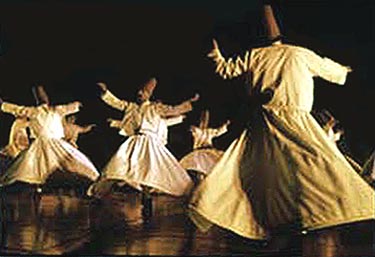
Samaa: Whirling Dervish Dance
With the exception of Kamaal Kojandi and the followers of
Rumi, no other Sufi group would approach this dance. It has to be noted
that
this dance called Samaa roots back to ancient times. In fact this dance
is a mix of
movements, impressions and sounds, which cause trance-like state. In
the
ancient times Samaa was used to climax the gatherings of people. But in
Rumi
following and others who subscribed to Samaa, the dance was the
commencement of
the gatherings.
The roots of Samaa are not
just found in Iran. Samaa orgies
as large as several thousand people were held in Asia Minor, Greece,
the
islands of Aegean Sea and Rome. There are recorded historical evidence
to this
claim. In the ancient times mostly women participated in the Samaa
dances.
Four hundred years before the
Birth of Christ, the Roman
Senate attempted to ban this dance, however never succeeded in truly
suppressing it. The performers migrated to northern and southern
vineries for
their rituals.
In Samaa orgies, sometimes the
women were driven into
violent states of mind, which caused them to tear their infants apart,
by their
own teeth.
For about four hundred years
this form of Samaa proliferated
in Asia Minor, Greece and the Western regions of Iran and the southern
parts of
the Alborz Mountain (Tehran region).
The advent of Islam
extinguished inhumane parts of Samaa
dances and mostly forgotten. However we see that the Samaa infiltrated
the Sufi
houses of the Asia Minor before other places.
Although because of the
Naqshbandi Sufi influence Samaa did
not roam the Uzbekistan (Russia) area, however the Tabriz (Iran) Samaa
had
spread roots. Many of the early Sufi movements did not take kindly to
Samaa and
consider it improper for Muslim ceremonies and actually was forbidden
for the
most part.
During the 6th century of Islam (1300s) we see
the beginnings of Samaa dances. We hear stories about Shahriaar
Kazerooni
breaking his ankle due to excessive dancing in the Sufi school of Khajoo
Kermani.
In 7th century of Islam Rumi himself
freely
performed Samaa dances, evident from Mathnavi Vol. Four:
Therefore Samaa, the food for
lovers has been brought forth
Within these dreams of
socializing, served (amongst the
lovers)
First there were movements and
reciting poetry and later on
music was added. These dances created a state of trance during which
the Sufi
poets composed their poetry that has lasted to the present day. The
purpose of
Samaa was to become self-less (like a runner’s high) where the mind
would focus
on spiritual poetry and performance with the singular goal of praising
one God.
Indeed the last Sufi school,
which has maintained Samaa, is
the Rumi’s. The Westerners saw these dances in Qunieh, Rumi’s
headquarters, and
called it the Whirling Dervish Dance. Samaa is absent however from the
western
Arab regions of Middle East.
Rumi’s version of Samaa is as
following: anchoring the right
foot on the ground and whirling with the rhythm of music and waving the
arms in
the air. Rumi’s school has turned Samaa into an act of worship.
In some Sufi schools women
dressed as men participated in the
Samaa. In some cases the women performed separately.
Source: Eraj Gholesorkhi
Introduction to Divan (poems)
of Kamaal Kohjandi
Tehran, Iran 1995
Sorosh Press
End.
My personal judgment about
Samaa is that of caution. Clearly
amongst certain sects of religions in Iran Samaa was used to fall into
trance and allow spirits to possess bodies. Miraculous acts were
performed to
enchant the eyes of the spectators. Forms of Sanaa later on infiltrated
parts
of Western African and brought to Caribbean Islands like Haiti via the
slave
ships.
As a Muslim I do not subscribe
to this application of Samaa
and consider it as Demon worshiping. However in Rumi’s version if the
dance is
used to focus one’s mind on the poetry in a worship-like posture, still
being
cautious I can understand the art form of it.
Strict Sunni adherence which I
personally enjoy does not
find comfort with any form of Samaa simply because we do not find this
dancing
amongst the traditions of our beloved Prophet Mohammad Peace Be Upon
Him.
However, there is no 100%
religious argument against an art
form that produces such magnificent human emotions for the Lord.
Allah
knows the final truth.
©
2003-2002, Dara Shayda

